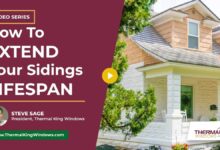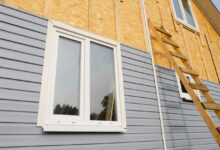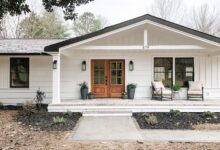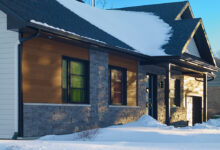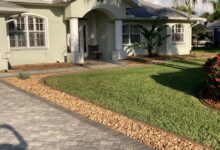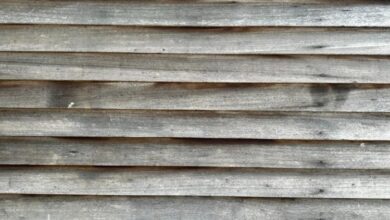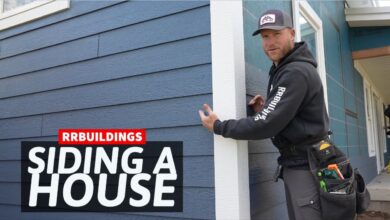How Weather-Resistant Siding Protects Your Home Year-Round
How Weather-Resistant Siding Protects Your Home Year-Round: Protecting your home from the elements is paramount, and choosing the right siding can significantly impact its longevity and curb appeal. This guide explores the benefits of weather-resistant siding, detailing its protective qualities against various weather conditions, long-term cost savings, and aesthetic advantages. We’ll delve into different siding materials, installation best practices, and maintenance tips to help you make an informed decision for your home.
From withstanding torrential rain and powerful winds to resisting snow, ice, and hail, weather-resistant siding offers unparalleled protection. We will examine how different materials perform under various climatic conditions and explore the long-term financial and environmental benefits associated with this investment. Discover how the right siding can enhance your home’s energy efficiency, reduce maintenance needs, and boost its overall aesthetic value.
Introduction
Choosing the right siding for your home is a crucial decision impacting both its aesthetic appeal and its longevity. Weather-resistant siding offers superior protection against the elements, extending the life of your home and minimizing costly repairs. This superior protection translates to significant long-term savings and peace of mind.
Weather-resistant siding encompasses a range of materials engineered to withstand various environmental challenges. These materials share key characteristics that contribute to their effectiveness, ultimately safeguarding your investment.
Types of Weather-Resistant Siding Materials
Several materials provide exceptional weather resistance. Each offers a unique combination of durability, aesthetics, and maintenance requirements. Understanding these differences is key to selecting the best option for your specific needs and budget.
- Vinyl Siding: A popular choice due to its affordability and low maintenance. Vinyl is resistant to moisture, rot, and insect damage. Its color is embedded, minimizing fading over time. However, it can be susceptible to damage from impact.
- Fiber Cement Siding: A composite material combining cement, cellulose fibers, and other additives. Fiber cement boasts exceptional durability, fire resistance, and resistance to pests and rot. It mimics the look of wood but requires more maintenance than vinyl.
- Aluminum Siding: Lightweight and resistant to rust and corrosion, aluminum siding is a durable option, particularly suitable for coastal areas prone to salt spray. However, it can dent easily.
- Engineered Wood Siding: Advances in wood treatment technologies have produced engineered wood siding with enhanced resistance to moisture and decay. These products often combine treated wood with protective coatings to extend their lifespan.
Key Features of Weather-Resistant Siding
The effectiveness of weather-resistant siding stems from a combination of properties designed to protect your home from various environmental threats.
- Water Resistance: Effective siding prevents water penetration, reducing the risk of mold, mildew, and structural damage. This is achieved through materials with low water absorption rates and tight interlocking seams.
- Impact Resistance: The ability to withstand impacts from hail, debris, or accidental bumps is a crucial factor. Some materials are inherently more impact-resistant than others.
- UV Resistance: Prolonged exposure to sunlight can cause fading and degradation. UV-resistant siding materials are formulated to minimize this effect, preserving the siding’s color and integrity.
- Resistance to Pests and Rot: Certain materials are inherently resistant to insect infestation and rot, reducing the need for costly repairs and replacements.
Beneficial Applications of Weather-Resistant Siding
Weather-resistant siding provides significant advantages in various geographic locations and climates.
Homes situated in coastal areas, for instance, benefit immensely from the superior protection offered against salt spray and moisture. The corrosive effects of saltwater can rapidly degrade traditional siding materials, while weather-resistant options offer greater longevity. Similarly, homes in regions with extreme temperature fluctuations, experiencing both scorching summers and freezing winters, will experience reduced wear and tear from the expansion and contraction of materials. The ability of weather-resistant siding to withstand these stresses translates to significant long-term cost savings and reduced maintenance.
Protection Against Specific Weather Conditions
Weather-resistant siding offers crucial protection to your home, safeguarding it from the damaging effects of various weather elements year-round. Choosing the right siding significantly impacts your home’s longevity and curb appeal, mitigating costly repairs and maintenance. The level of protection varies depending on the material chosen, its installation, and the severity of the weather conditions.
Rain and Moisture Damage Protection
Weather-resistant siding effectively protects your home from rain and moisture damage through its inherent properties and design. Materials are selected for their resistance to water absorption, preventing the penetration of moisture into the underlying structure. This prevents issues such as rot, mold growth, and structural damage. Proper installation, including the use of flashing and caulking, further enhances this protection.
| Siding Material | Water Resistance | Maintenance Needs | Lifespan (Years) |
|---|---|---|---|
| Vinyl | High; virtually impervious to water | Low; occasional cleaning | 20-50 |
| Fiber Cement | High; resists water absorption | Moderate; periodic painting or staining | 30-50+ |
| Wood | Low to Moderate; depends on treatment | High; regular sealing and painting | 15-30+ (depending on treatment and maintenance) |
| Aluminum | High; naturally water-resistant | Low; occasional cleaning | 30-50+ |
Wind Damage Protection
High winds can cause significant damage to homes, including siding failure. Weather-resistant siding, particularly those designed with impact resistance, effectively withstands strong winds. The strength of the material, coupled with proper installation techniques like secure fastening, ensures that the siding remains firmly attached during even the most severe storms. For example, fiber cement siding, known for its durability and strength, is highly resistant to wind uplift. Proper installation of any siding type is critical for wind protection.
Snow and Ice Accumulation Protection
Heavy snow and ice accumulation can put considerable stress on a home’s exterior. Weather-resistant siding, due to its durability and design, helps prevent damage caused by the weight of snow and ice. The ability of the siding to withstand the weight minimizes the risk of structural damage to the underlying walls. Furthermore, certain siding materials, like vinyl, are less likely to crack or break under the pressure of ice expansion.
Hail Damage Resistance
Hail can inflict significant damage to a home’s exterior. The impact resistance of different siding materials varies considerably. Vinyl siding, while offering good protection against rain and wind, may dent or crack under hail impact. Fiber cement siding, on the other hand, offers superior hail resistance due to its density and strength. Aluminum siding also demonstrates good hail resistance, although it can dent. The size and impact force of the hail significantly influence the level of damage sustained, regardless of the siding material.
Long-Term Benefits and Cost Savings
Investing in weather-resistant siding offers significant long-term advantages that extend far beyond its initial cost. The durability and protection it provides translate directly into substantial savings over the lifespan of your home, minimizing expenses associated with repairs, maintenance, and energy consumption. This section will detail these cost-saving benefits and illustrate the return on investment associated with choosing a high-quality, weather-resistant siding option.
Choosing weather-resistant siding reduces the overall cost of homeownership over time. This is achieved through decreased maintenance, reduced repair needs, and improved energy efficiency, leading to lower utility bills. The initial investment is offset by these long-term savings, resulting in a more cost-effective solution compared to less durable materials that require more frequent attention.
Cost Savings Associated with Weather-Resistant Siding
The superior resilience of weather-resistant siding translates into tangible financial benefits. The following points highlight the key areas where cost savings are realized:
- Reduced Repair and Replacement Costs: Weather-resistant siding is designed to withstand harsh weather conditions, minimizing the need for frequent repairs or premature replacements. Unlike traditional siding materials that may be damaged by extreme temperatures, moisture, or strong winds, weather-resistant options maintain their integrity for a longer period, saving you the expense of costly repairs or complete siding replacements.
- Lower Maintenance Expenses: The low-maintenance nature of weather-resistant siding significantly reduces the cost associated with cleaning, painting, and other upkeep. Many weather-resistant siding options require minimal cleaning and resist fading, eliminating the need for frequent repainting or surface treatments.
- Decreased Insurance Premiums: In some cases, homes with weather-resistant siding may qualify for reduced homeowner’s insurance premiums. Insurance companies often recognize the enhanced protection offered by these materials and reward homeowners with lower rates, reflecting the reduced risk of damage.
- Increased Home Value: The improved aesthetic appeal and enhanced durability of weather-resistant siding can contribute to a higher resale value for your home. Potential buyers are often willing to pay a premium for a property with well-maintained, long-lasting exterior features.
Reduced Need for Frequent Repairs and Maintenance
Weather-resistant siding is engineered to withstand the elements, significantly reducing the frequency of repairs and maintenance compared to traditional siding. This durability translates into less time and money spent on upkeep. For instance, materials like fiber cement siding are resistant to rot, insect infestation, and fire, eliminating the need for costly repairs associated with these issues. Similarly, vinyl siding’s resistance to moisture and fading means less frequent repainting and surface treatments are required. The reduced need for repairs contributes to long-term cost savings and provides peace of mind.
Impact on Home Energy Efficiency
Weather-resistant siding contributes to improved home energy efficiency by providing a superior barrier against heat transfer. Many options incorporate insulation properties that help maintain a consistent indoor temperature, reducing reliance on heating and cooling systems. This results in lower energy bills and a smaller carbon footprint. For example, certain types of insulated vinyl siding can significantly reduce heat loss in winter and heat gain in summer, resulting in measurable energy savings over time. The energy efficiency benefits contribute to long-term cost savings and environmental sustainability.
Aesthetic Considerations and Design Choices
Choosing weather-resistant siding offers a significant opportunity to enhance your home’s curb appeal and overall aesthetic. The wide variety of materials, colors, and textures available allows for personalized expression and seamless integration with your home’s architectural style. Careful consideration of these aesthetic elements can dramatically improve your property’s value and visual impact.
The aesthetic appeal of different weather-resistant siding materials varies considerably. Each material possesses unique textural qualities and visual characteristics that contribute to the overall look of a home. For instance, the clean lines and modern feel of fiber cement siding differ significantly from the rustic charm of wood-look vinyl siding, or the sleek, contemporary appearance of metal siding. Understanding these inherent differences is crucial for making an informed decision that aligns with your personal preferences and the style of your home.
Siding Material Aesthetics and Their Impact
Fiber cement siding offers a sophisticated, low-maintenance option that mimics the look of natural wood or stucco, providing a clean and timeless aesthetic. Vinyl siding, while offering a wide range of colors and textures, often presents a more uniform, less textured look, though advancements have resulted in products that convincingly mimic wood grain. Metal siding, frequently used in modern or industrial designs, provides a sleek and contemporary appearance. Its smooth surface reflects light differently than other materials, creating a distinctly modern feel. Wood siding, while beautiful, requires significant maintenance and is not as weather-resistant as other options unless treated appropriately, offering a rustic and traditional aesthetic.
Color and Texture Enhancements for Curb Appeal
Strategic use of color and texture can dramatically enhance a home’s curb appeal. Light-colored siding, such as creamy whites or soft grays, can make a home appear larger and brighter, especially in shaded areas. Darker colors, such as deep blues or charcoal grays, can create a more dramatic and sophisticated look, though they might require more frequent cleaning to maintain their appearance. Textured siding, such as clapboard or shingle styles, adds visual interest and depth, while smooth siding creates a cleaner, more contemporary feel. For example, a home with a traditional design might benefit from warm, earthy tones and a textured siding that mimics natural wood, while a modern home might look stunning with sleek, dark gray or black smooth siding.
Siding Choices and Architectural Styles
Consider a hypothetical scenario: a Victorian-style home versus a contemporary ranch-style home. The Victorian home, characterized by intricate detailing and ornamentation, would be beautifully complemented by a fiber cement siding in a light, warm color, perhaps with a slightly textured finish to mimic wood shingles, echoing the home’s historical details. The contemporary ranch, however, would benefit from a clean, minimalist approach. Metal siding in a sleek, dark gray or charcoal would perfectly accentuate the home’s straight lines and modern aesthetic. In contrast, using the metal siding on the Victorian home would clash dramatically with its delicate architectural features, while the fiber cement siding on the ranch might appear too fussy and detract from its clean lines. The careful selection of siding material and color can therefore either enhance or detract from a home’s architectural style, significantly impacting its overall visual appeal.
Installation and Maintenance
Proper installation and regular maintenance are crucial for maximizing the lifespan and protective capabilities of your weather-resistant siding. Neglecting these aspects can lead to premature damage, reduced energy efficiency, and costly repairs. This section details best practices for installation and a simple maintenance schedule to keep your siding looking its best and performing optimally for years to come.
Installation Best Practices
Ensuring correct installation is paramount to achieving the advertised weather protection. Improper installation can compromise the siding’s integrity, leading to leaks, water damage, and compromised energy efficiency. Key aspects include using appropriate fasteners, maintaining consistent spacing, and ensuring proper flashing around windows and doors. Professional installation is highly recommended, as experienced installers possess the knowledge and tools to address any site-specific challenges and ensure a flawless finish. They can also identify and rectify potential issues before they become major problems. For example, they would know to account for expansion and contraction of the siding material due to temperature fluctuations.
Ventilation Behind Siding
Adequate ventilation behind the siding is essential for preventing moisture buildup. Trapped moisture can lead to rot, mold growth, and damage to the underlying structure of your home. This is especially important in climates with high humidity or frequent rainfall. Proper ventilation allows air to circulate, carrying away moisture and preventing condensation. This can be achieved through the use of vented soffits and ridge vents, creating a continuous airflow path from the bottom to the top of the wall cavity. Failure to properly ventilate can result in significant long-term damage, necessitating costly repairs or even complete siding replacement.
Regular Maintenance Procedures
Regular inspection and cleaning of your weather-resistant siding will extend its lifespan and maintain its aesthetic appeal. A simple annual inspection can identify and address minor issues before they escalate into major problems. This involves checking for loose or damaged siding, signs of water damage, and any pest infestations. Prompt attention to these issues can prevent costly repairs down the line. For example, a small crack in the siding, if left unaddressed, could allow water penetration and lead to significant rot over time.
Cleaning Different Types of Weather-Resistant Siding
Cleaning methods vary depending on the type of siding material. Vinyl siding is generally easy to clean, often requiring only a solution of mild detergent and water applied with a soft-bristled brush. Pressure washing should be avoided as it can damage the surface. For fiber cement siding, a similar approach can be used, but more care should be taken to avoid scratching the surface. Wood siding may require more specialized cleaning solutions and techniques, depending on the type of finish. Always refer to the manufacturer’s recommendations for cleaning specific siding materials to ensure you’re using the appropriate methods and cleaning agents to avoid damage. For instance, harsh chemicals can damage the protective coating of some siding types.
Environmental Impact
Choosing weather-resistant siding isn’t just about protecting your home; it’s about making an environmentally conscious decision. The materials used, their manufacturing processes, and their lifespan all contribute to the overall environmental footprint of your home’s exterior. Understanding these factors allows for informed choices that minimize impact and maximize sustainability.
Many modern weather-resistant siding options offer significant environmental benefits compared to traditional materials. These benefits stem from both the materials themselves and the reduced need for frequent replacements due to weather damage. This section will explore the environmental impact of various siding materials, highlighting their lifecycle considerations and the sustainability aspects of responsible choices.
Recycled Content and Reduced Waste
The incorporation of recycled materials in siding production is a key factor in reducing environmental impact. For example, some vinyl sidings utilize recycled PVC, diverting waste from landfills and reducing the demand for virgin materials. Similarly, fiber cement siding often includes recycled fly ash and other industrial byproducts, further minimizing waste and resource depletion. The use of recycled content reduces the energy required for manufacturing and lowers greenhouse gas emissions associated with the extraction and processing of new materials. Furthermore, durable siding that resists damage reduces the need for replacements, thus lessening the waste generated over the building’s lifespan. A house with long-lasting siding avoids the landfill impact of frequent replacements.
Lifecycle Assessment of Siding Materials
A complete environmental assessment considers the entire lifecycle of a siding material, from raw material extraction and manufacturing to installation, use, and eventual disposal or recycling. Wood siding, while a natural material, can have a significant environmental impact depending on its source and treatment. Harvested wood requires responsible forestry practices to avoid deforestation and habitat loss. Furthermore, treated wood often contains chemicals that can leach into the soil and water. In contrast, fiber cement siding, while requiring energy-intensive manufacturing, generally has a longer lifespan and is more resistant to damage, reducing the overall environmental impact over its lifetime. Vinyl siding, while often criticized for its non-biodegradability, can incorporate recycled content and has a relatively low maintenance cost, contributing to a potentially lower overall environmental footprint compared to materials requiring frequent replacement.
Sustainability Aspects of Specific Siding Choices
Several siding options stand out for their sustainability features. For example, sustainably harvested wood siding, certified by organizations like the Forest Stewardship Council (FSC), ensures responsible forestry practices and minimal environmental disruption. This certification verifies that the wood comes from forests managed to meet specific environmental and social standards. Engineered wood siding, which often uses recycled wood fibers, provides a more sustainable alternative to solid wood in many instances. Additionally, certain manufacturers offer siding with high recycled content percentages, minimizing the use of virgin materials and reducing the overall carbon footprint of the product. These choices, while potentially slightly more expensive initially, offer long-term environmental and economic benefits.
Conclusion
Investing in weather-resistant siding is a smart decision that safeguards your home, saves you money in the long run, and enhances its beauty. By understanding the various options available, their respective benefits, and proper installation and maintenance techniques, you can ensure your home remains protected and aesthetically pleasing for years to come. Consider the climate in your region, your budget, and your aesthetic preferences when selecting the ideal siding for your property. With the right choice, you can enjoy peace of mind knowing your home is well-protected against the elements.
